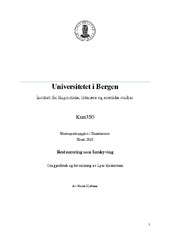| dc.contributor.author | Hjeltnes, Marie | |
| dc.date.accessioned | 2016-01-05T12:28:31Z | |
| dc.date.available | 2016-01-05T12:28:31Z | |
| dc.date.issued | 2015-11-20 | |
| dc.date.submitted | 2015-11-20 | eng |
| dc.identifier.uri | https://hdl.handle.net/1956/10870 | |
| dc.description.abstract | Lyse klosterruiner er ruinane etter klosteret Heilage Maria Kloster i Lyse (1146) eller betre kjend som bare Lyse kloster, dotterkloster av Fountains Abbey i England. Lyse klosterruin er lokalisert i Os kommune cirka 24 kilometer søraust for Bergen sentrum. Ruinen har hovudsakleg hatt to grundige restaurerings/konserveringsomgangar sidan den blei utgraven på 1800-tallet, i tillegg til fleire små reperasjonsarbeid. Lyse klosterruin er i skrivande stund inne i ei ny konserveringsprosess under leiinga av Byantikvaren i Bergen kommune og Os kommune. Dette er det største konserveringsarbeidet utført ved klosterruinen sidan 1920-tallet, og det har potensiale til å medføre store endringar i forvaltning og oppleving av ruinen. Med Lyse Klosterruiner som utgangspunkt vil eg ta for meg korleis synet på fortidsminner har blitt endra dei siste år hundra, og særlig synet på ruiner. I denne teksten kommer eg til å fokusere på kulturminnevernet i Noreg, og sjå nærmare på dei endringane som har vore med på å forskyve verdien og funksjonen vi tillegger fortidsminner. Lyse klosterruin er særskilt interessant for ho står for ei del av Noregs historie som nordmenn flest veit lite om, klostertida. Eg vil sette dette inn i ein europeisk samanheng fordi mye av utviklinga i Noreg har skjedd parallelt med og/eller som følgje av tendensar i fortidsminnevernet i Europa. For å kunne sjå nærmare på denne forandringa som teorien og praksisen kring bevaringa av fortidsminner har gjennomgått skal vi fokusere på Lyse klosterruin sin historie. Med den sveitsiske kunsthistorikaren Dario Gamboni (1954-) sin teori om dislocation, som eg har oversett til forskyving, som utgangspunkt vil eg forsøk spore forskyvingane frå mellomalderen til i dag som liggje til grunn for dagens klosterruin. Kva slags samfunnsendringar liggjar som årsak for desse forskyvingane? Eg vil vurdera desse forskjellige forskyvingane, og forsøka finne kor dei kjem i frå og korleis dei har påverka vårt syn på Lyse klosterruin. Eg vil også sjå nærmare på den dokumentasjonen vi har på ruinens fysiske utvikling frå den var ferdig bygd i mellomalderen til den blei restaurert på 1900-tallet for å diskutera samspelet mellom den fysiske forskyvinga og ruinen. Som kontrast til Gambonis forskyvingsteori vil eg ta opp den amerikanske kunstfilosofen Florence Hetzler (1926-1991) sine teoriar rundt ruinens estetikk og særskilt hennar omgrep ruin time. | en_US |
| dc.description.abstract | Lyse Abbey is a monastery located in Os. Founded in 1146 by monks from the Cistercian orderas a daughter abbey of the English monastery Fountains Abbey. I will look into the history of Lyse Abbey from its foundation until today. I will also do an overview of the history of the Cistercian order and especially with focus on the Cistercian architecture as a background for the abbey in Lyse. Since its foundation, Lyse Abbey has gone through many changes. The reformation in 1537 stands out as one of the more dramatic dislocations of value and function that Lyse Abbey went through. The restorations that Lyse has gone through the last 100 years is another dislocation that has had an immense effect on Lyse. The ruin after this abbey is today cultural heritage. With the Swiss art historian Dario Gambonis theory of dislocation, I will discuss some of the societal changes that has affected Lyse Abbey and how they can explain the physical changes of the ruin, and our perception of the ruin. I will as a contrast to Gambonis theory of dislocation, discuss the American art philosopher Florence Hetzlers theories around the ruin as a product of ruin time. I will us these theories as a background for discussing the restorations of Lyse Abbey and the dislocation of authenticity. I will discuss the dislocation of the ruin related to a changing of contexts. Lastly I will do an overview over the history of cultural heritage management and see how it relates to the changes we have seen at Lyse Abbey. | en_US |
| dc.format.extent | 11426249 bytes | eng |
| dc.format.mimetype | application/pdf | eng |
| dc.language.iso | nno | eng |
| dc.publisher | The University of Bergen | eng |
| dc.subject | Kulturminner | eng |
| dc.subject | Lyse kloster | eng |
| dc.subject | ruin | eng |
| dc.subject | kulturminnevern | eng |
| dc.title | Restaurering som forskyving. Om gjenbruk og forvaltning av Lyse klosterruin | eng |
| dc.type | Master thesis | |
| dc.rights.holder | Copyright the author. All rights reserved | eng |
| dc.description.degree | Master i Kunsthistorie | |
| dc.description.localcode | MAHF-KUN | |
| dc.description.localcode | KUN350 | |
| dc.subject.nus | 713203 | eng |
| fs.subjectcode | KUN350 | |
